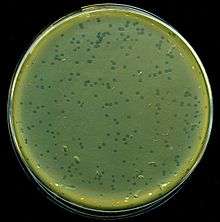Phage typing

Phage typing is a method used for detecting single strains of bacteria. It is used to trace the source of outbreaks of infections.[1] The viruses that infect bacteria are called bacteriophages ("phages" for short) and some of these can only infect a single strain of bacteria. These phages are used to identify different strains of bacteria within a single species.
A culture of the strain is grown in the agar and dried. A grid is drawn on the base of the petri dish to mark out different regions. Inoculation of each square of the grid is done by a different phage. The phage drops are allowed to dry and are incubated: The susceptible phage regions will show a circular clearing where the bacteria have been lysed, and this is used in differentiation.[2]
References
- ↑ Baggesen DL, Sørensen G, Nielsen EM, Wegener HC. Phage typing of Salmonella Typhimurium - is it still a useful tool for surveillance and outbreak investigation?. Eurosurveillance. 2010;15(4):19471. PMID 20122382.
- ↑ Turbadkar SD, Ghadge DP, Patil S, Chowdhary AS, Bharadwaj R (April 2007). "Circulating phage type of Vibrio cholerae in Mumbai". Indian Journal of Medical Microbiology. 25 (2): 177–8. doi:10.4103/0255-0857.32738. PMID 17582202.